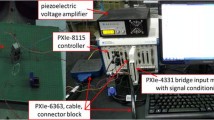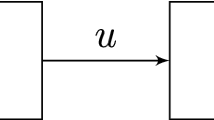Abstract
Inherently, piezoelectric actuator is one of the devices equipped with the micrometer positioning capability and characterized by small size, fast response, high stiffness, and large blocking force. These advantages give piezoelectric actuator the possibility of being high-accuracy industrial machineries. However, factors of nonlinear hysteresis, modeling uncertainties, and environmental disturbances result in unacceptable positioning errors and greatly increase the control difficulties. In this paper, a hybrid nonlinear robust control design that integrates a feedback linearization control method and a robust compensator is proposed. It aims to eliminate above-mentioned impacts and tackle the micrometer (μm) positioning design of piezoelectric actuators. The feedback linearization controller is developed for converging of positioning errors exponentially. The robust compensator is used to mitigate the total impact of hysteresis, modeling uncertainties and environmental disturbances and carry out the fine tuning of positioning errors to zero. Simulation results and practical tests reveal that the controlled piezoelectric actuator reaches 1 μm positioning accuracy, and the proposed robust control law delivers promising positioning performance under impacts of hysteresis, modeling uncertainties and environmental disturbances.












Similar content being viewed by others
References
Basar T, Bernhard P (1995) H∞-optimal control and related minimax design problems: A dynamic game approach. Birkhauser, Basel
Basar T, Olsder GJ (1999) Dynamic noncooperative game theory. Society for Industrial and Applied Mathematics, 2 edn. Philadelphia
Brokate M, Sprekels J (1996) Hysteresis and phase transitions, vol. 121. Springer Science & Business Media. https://doi.org/10.1007/978-1-4612-4048-8
Faa-Jeng L, Rong-Jong W, Kuo-Kai S, Tsih-Ming L (2001) Recurrent fuzzy neural network control for piezoelectric ceramic linear ultrasonic motor drive. IEEE Trans Ultrason Ferroelectr Freq Control 48:900–913. https://doi.org/10.1109/58.935707
Ismail M, Ikhouane F, Rodellar J (2009) The hysteresis Bouc–Wen model, a survey. Arch Comput Methods Eng. https://doi.org/10.1007/s11831-009-9031-8
Iyer RV, Tan X, Krishnaprasad PS (2005) Approximate inversion of the Preisach hysteresis operator with application to control of smart actuators. IEEE Trans Autom Control. https://doi.org/10.1109/tac.2005.849205
Jiles DC, Atherton DL (1986) Theory of ferromagnetic hysteresis. J Magn Magn Mater. https://doi.org/10.1016/0304-8853(86)90066-1
Kennedy J, Eberhart R (1995) Particle swarm optimization. In: Proceedings of IEEE international conference on neural networks. https://doi.org/10.1109/icnn.1995.488968
Kuhnen K (2003) Modeling, identification and compensation of complex hysteretic nonlinearities: a modified Prandtl-Ishlinskii approach. Eur J Control. https://doi.org/10.3166/ejc.9.407-418
Low TS, Guo W (1995) Modeling of a three-layer piezoelectric bimorph beam with hysteresis. J Microelectromech Syst. https://doi.org/10.1109/84.475550
Mao J, Ding H (2009) Intelligent modeling and control for nonlinear systems with rate-dependent hysteresis. Sci China Ser F Inf Sci 52:656–673. https://doi.org/10.1007/s11432-009-0026-8
Mayergoyz ID (1988) Dynamic Preisach models of hysteresis. IEEE Trans Magn 24:2925–2927. https://doi.org/10.1109/20.92290
Rakotondrabe M (2011) Bouc-Wen modeling and inverse multiplicative structure to compensate hysteresis nonlinearity in piezoelectric actuators. IEEE Trans Autom Sci Eng. https://doi.org/10.1109/tase.2010.2081979
Webb GV, Lagoudas DC, Kurdila AJ (1998) Hysteresis modeling of SMA actuators for control applications. J Intell Mater Syst Struct. https://doi.org/10.1177/1045389x9800900605
Wei J-D, Sun C-T (2002) Large simulation of hysteresis systems using a piecewise polynomial function. IEEE Signal Process Lett 9:207. https://doi.org/10.1109/LSP.2002.801726
Xu HG, Ono T, Esashi M (2006) Precise motion control of a nanopositioning PZT microstage using integrated capacitive displacement sensors. J Micromech Microeng 16:2747–2754. https://doi.org/10.1088/0960-1317/16/12/031
Acknowledgements
This investigation was supported by Ministry of Science and Technology financially, Taiwan, ROC (Grant No. MOST104-2628-E-006-012-MY3).
Author information
Authors and Affiliations
Corresponding author
Ethics declarations
Conflict of interest
The authors declare no conflict of interest.
Additional information
Publisher's Note
Springer Nature remains neutral with regard to jurisdictional claims in published maps and institutional affiliations.
Appendix
Appendix
Proof of Theorem 1
The mini-max positioning performance index in Eq. (23) can be rewritten as:
Considering the nonzero initial condition of \({\mathbf{\tilde{e}(0)}} \ne 0\), the mini-max positioning performance index (28) is modified as:
For deriving the robust compensator ur(t) and the Riccati-like equation, a cost function is defined as:
Equation (30) is calculated as:
Substitute the positioning error dynamics \({\mathbf{\dot{\tilde{e}}(t)}} = {\mathbf{A}}_{{\mathbf{r}}} {\mathbf{\tilde{e}(t)}} + {\mathbf{B}}_{{\mathbf{r}}} u_{r} (t) + {\mathbf{B}}_{{\mathbf{r}}} \tilde{w}(t)\) into Eq. (31), then we have
Reorganize Eq. (32), then
Completing the squares, the following result can be obtained
Choosing the robust compensator \(u_{r} (t) = - R_{r}^{ - 1} {\mathbf{B}}_{{\mathbf{r}}}^{T} {\mathbf{P}}_{{\mathbf{r}}} {\mathbf{\tilde{e}(t)}}\) for Eq. (34), the Riccati like equation \({\mathbf{A}}_{{\mathbf{r}}}^{T} {\mathbf{P}}_{{\mathbf{r}}} + {\mathbf{P}}_{{\mathbf{r}}} {\mathbf{A}}_{{\mathbf{r}}} + {\mathbf{Q}}_{{\mathbf{r}}} - {\mathbf{P}}_{{\mathbf{r}}} {\mathbf{B}}_{{\mathbf{r}}} \left[ {R_{r}^{ - 1} - \frac{1}{{\rho^{2} }}I} \right]{\mathbf{B}}_{{\mathbf{r}}}^{T} {\mathbf{P}}_{{\mathbf{r}}} = 0\), and the worst disturbance \(\tilde{w}(t) = \frac{1}{{\rho^{2} }}{\mathbf{B}}_{{\mathbf{r}}}^{T} {\mathbf{P}}_{{\mathbf{r}}} {\mathbf{\tilde{e}(t)}}\), Eq. (34) can be further expressed as
According the definition of the cost function \(J({\tilde{\mathbf{e}}},u_{r} ,\tilde{w})\), we have
From Eq. (36), if the initial condition is \({\tilde{\mathbf{e}}}\left( 0 \right) = 0\), the mini-max positioning performance in Eq. (23) can be proven.□
Rights and permissions
About this article
Cite this article
Chen, Y.Y., Huang, M.H. & Tsai, Y.L. Nonlinear control design of piezoelectric actuators with micro positioning capability. Microsyst Technol 27, 1589–1599 (2021). https://doi.org/10.1007/s00542-019-04437-9
Received:
Accepted:
Published:
Issue Date:
DOI: https://doi.org/10.1007/s00542-019-04437-9




